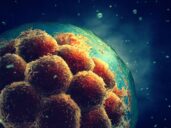
Embryonic stem cell-derived embryos (ESCDEs) have been around for a long time.
Last year, an ESCDE, assembled from mouse cells in vitro, replicated natural mouse embryo development in utero up to day 8.5 post-fertilisation. In mouse gestation terms, this amounts to the completion of gastrulation and the start of organ formation and neurulation.
In February this year, scientists were able to grow stem cell-derived human blastocyst-like entities termed ‘blastoids’, which replicated the process of implantation into endometrial organoids. Last month (April 2023), a similar feat was announced with blastoids created from embryonic stem cells from cynomolgus monkeys. Although most of the 484 in vitro blastoids became disorganised in a few days, five survived to Day 17. However, this research also transferred some of the blastoids in utero, where they triggered changes in the pregnancy of the surrogate mothers and developed as far as producing gestational sacs. The authors hailed their advance as a means to ‘dissect primate embryonic development without the same ethical concerns and access challenges in human embryo study‘. However, as such research progresses in primates, the knowledge gained will almost certainly be extended to humans at some point. When it does, the pressure to permit in-utero transfer will become irresistible.
Though the 14-day rule limit on experimentation on human embryos has been in place since the passing of the 1990 Human Fertilisation and Embryology Act, there has been increasing pressure to extend this limit ever since it became possible to grow human embryos in vitro for longer periods. Access to human embryos is currently sufficiently difficult for the Human Fertilisation and Embryology Authority (HFEA) to seek powers to make such access less restricted. It is understandable, therefore, that scientists working on human blastoids and journalists reporting on such research should always emphasise these entities as a way of avoiding the ethical difficulties of research on actual human embryos. But what if, as some have already suggested, these alleged synthetic embryo-like structures are actual embryos? Whatever the time limit placed in future on human embryo research, the question is also whether human blastoids are sufficiently like human embryos to be subject to the same time limit. If healthy cynomolgus monkeys are successfully born from implanted blastoids, surely it would be impossible to sustain the notion that these are merely synthetic embryo-like structures?
A recent article in Nature seeks to play down the ethical issues involved with blastoids since they do indeed circumvent both the ethical concerns and legal restrictions relating to experimentation on actual donated human embryos
However, as David Jones presciently pointed out two years ago, it was already inadequate even then to define an embryo solely in terms of the product of the fusion of egg and sperm, as embryos could already be produced by somatic cell transfer (SCT) cloning. Since Dolly the sheep made headline news in 1997, other cloned embryos growing to adulthood are now commonplace in farming, though not without their own ethical controversies.
Jones rightly points out that ‘a human embryo does not have the capacity of developing into a human being. It is a human being in the process of development‘ [emphasis mine]. If, as with SCT, it does prove possible to generate fully developed, non-human animals from blastoids, then it will be untenable to maintain a synthetic/real distinction of blastoids from embryos and the ethical and legal issues related to experimentation with both will be the same.
With regard to human embryos, if blastoids eventually prove to be human beings in the process of development because one develops into a viable, healthy human being, then laws governing the use of embryos should surely apply to blastoids as well. Unbelievers may well opine that ‘the smallest advance in biology generates large and horror-struck claims of playing God, of eugenics, or of worse‘. Christians, however, along with others who reject a materialist worldview, will inevitably speculate about how ‘ensoulment’ relates to the development of an adult from a blastoid should this occur.
The question is not new. In 2008, it was rightly signposted that ‘Advances in stem cell research may be provoking a kind of “God of the Gaps” retreat on the moral status of embryos’. The advent of ‘blastoids does not necessarily raise any new questions in this respect. Do we really understand the science implicit in the scriptural assertion that God breathed human life into inanimate clay (Genesis 2:7)? Theological disputes about ensoulment are far from new (see here and here, for example) and still retain a place in debate in clinical journals.



